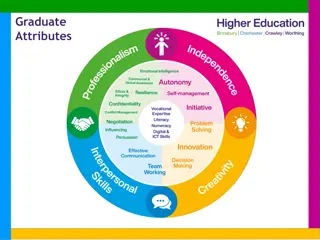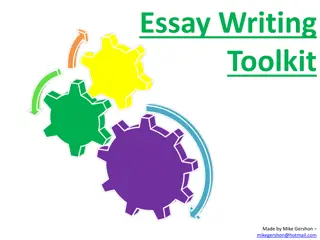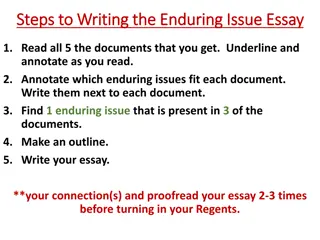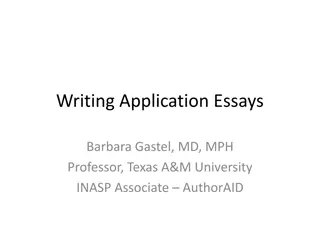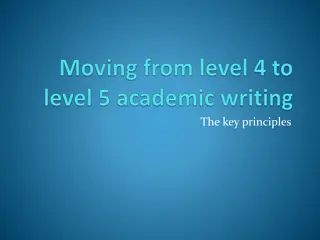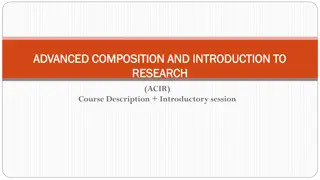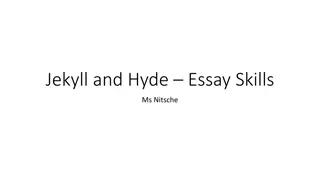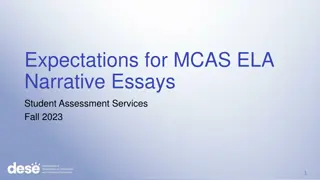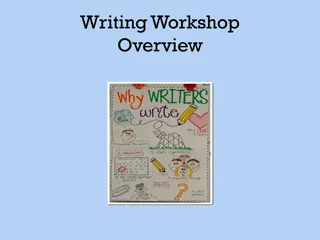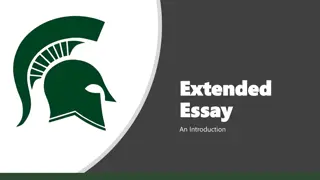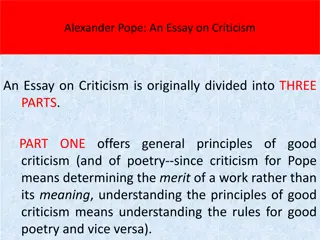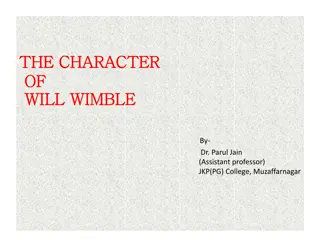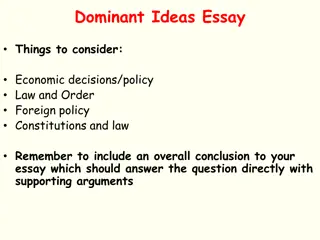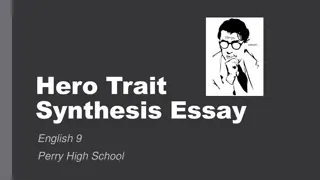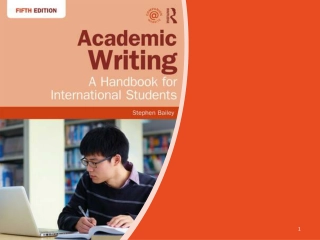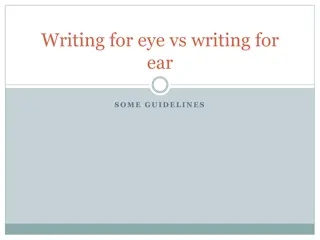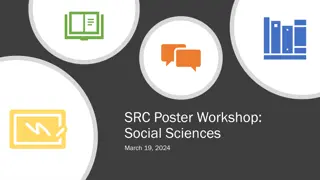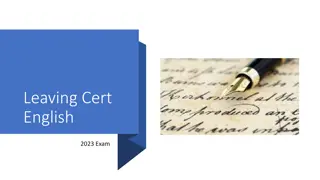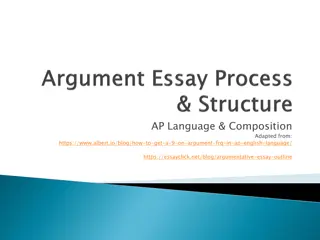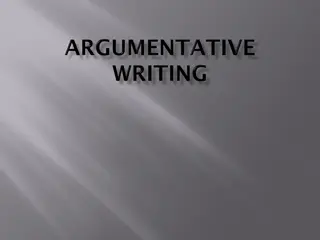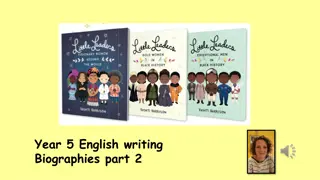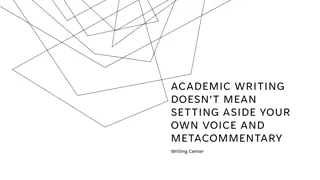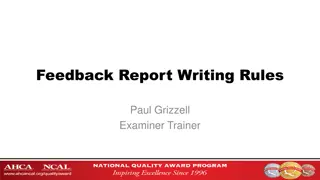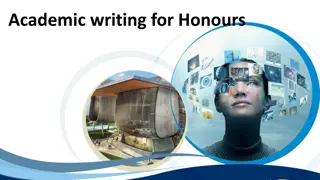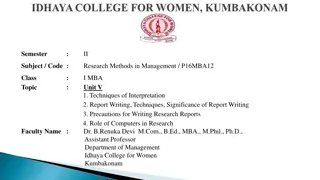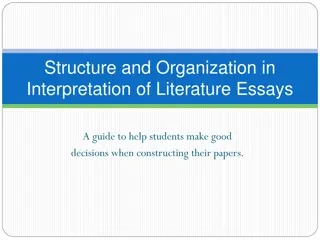Essay Writing: A Comprehensive Guide
Understand the essay types, academic essay structure, and the 3 stages of the writing process: preparation, writing, and revision. Learn how to craft a compelling introduction with goals like hooking the reader and formulating a thesis statement.
Uploaded on Jul 11, 2024 | 0 Views
Download Presentation

Please find below an Image/Link to download the presentation.
The content on the website is provided AS IS for your information and personal use only. It may not be sold, licensed, or shared on other websites without obtaining consent from the author. Download presentation by click this link. If you encounter any issues during the download, it is possible that the publisher has removed the file from their server.
E N D
Presentation Transcript
How to write an essay Planning, writing, and revising
What is an essay? Personal: Reflecting on the author s experiences Narrative: Describing contemporary or historical events Philosophical: Considering philosophical questions Political: Making specific political arguments Cultural: Commenting on a book, film, etc. Academic...
Academic essays... Come in various shapes and sizes Aim to persuade the reader with informed arguments Present and analyze evidence Contain an introduction, body, and conclusion
3 stages of the writing process 1. Preparation 2. Writing 3. Revision
The preparation stage Understand the assignment Choose a topic or question Read relevant sources Come up with a thesis statement Outline your structure
Writing an introduction
Goals of an introduction 1. Hook your reader 2. Provide background and context 3. Formulate your thesis statement 4. Provide an overview of the essay
1. Hook your reader Pique the reader s interest with a strong opening statement: The invention of Braille marked a major turning point in the history of disability.
2. Provide background and context Expand on your opening statement with the most relevant contextual information: The writing system of raised dots, widely used by blind and visually impaired people, was developed by Louis Braille in nineteenth-century France. Although it initially met with resistance from sighted people, Braille eventually became central to blind people s education and autonomy, giving them unprecedented access to cultural activities and social participation.
3. Formulate your thesis statement State the central argument you want to make your thesis statement: The success of Braille depended on acceptance among sighted people before the social status of blindness could truly be transformed, and this process was shaped by broader debates about disabled people s place in society.
4. Provide an overview of the essay Provide some signposting about your essay s structure: This essay begins by discussing the resistance Braille was met with from teachers. It then describes the contemporary beliefs about disability that informed this resistance. Subsequently, it asks to what extent the introduction of Braille facilitated a shift in these beliefs.
Length of the body Typical high-school essay has a three-paragraph body Longer essays may have multiple sections with headings The body should make up the majority of the essay Choose a structure that fits with your arguments
Each paragraph in the main body... Clearly relates to the main argument Has one central idea Is introduced with a topic sentence Transitions effectively from the previous paragraph Presents and interprets evidence
Topic sentences A topic sentence introduces a paragraph by indicating its topic: Although the Braille system gained immediate popularity with the blind students at the Institute in Paris, it had to gain acceptance among the sighted before its adoption throughout France.
Topic sentences The topic sentence transitions from the previous paragraph: Although the Braille system gained immediate popularity with the blind students at the Institute in Paris, it had to gain acceptance among the sighted before its adoption throughout France.
Topic sentences Then it introduces the topic of this paragraph: Although the Braille system gained immediate popularity with the blind students at the Institute in Paris, it had to gain acceptance among the sighted before its adoption throughout France.
Presenting evidence Support your arguments with evidence Evidence comes from various sources (e.g. books, journals) Quote or paraphrase evidence Cite your sources
Evidence is presented to... Prove a claim Provide background information Show the state of current research Show a different perspective Be critiqued
Presenting evidence Present evidence by quoting or paraphrasing: Many of the teachers at the Royal Institute for Blind Youth resisted learning Braille s system because they found the tactile method of reading difficult to learn (Bullock & Galst, 2009).
Interpreting evidence Interpret the evidence you have presented: This resistance was symptomatic of the prevalent attitude that the blind population had to adapt to the sighted world rather than develop their own tools and methods.
Your conclusion... Synthesizes the arguments made in the body Explores the broader implications Emphasizes the significance of your argument Finishes with a strong closing statement
Synthesizing your arguments Begin your conclusion by summarizing and drawing connections between the various arguments you ve made: Braille radically enhanced blind people s autonomy and changed cultural understandings of blindness. But the emergence of Braille did not depend solely on the technical evolution of tactile reading; it also required the societal acceptance of blind people as valuable enough to merit a separate reading system.
Broader implications Suggest what further implications your argument has, beyond those explored in the essay: New tools of accessibility are always shaped by their social contexts, but they also shape social conditions in turn.
Stressing the topics importance Suggest to the reader why your topic, and the arguments you have made about it, are significant: The success of Braille was not limited to the practical advantages of tactile reading; its enduring significance was in providing blind people broader access to culture and concomitant gains in social status.
Strong closing statement Conclude your essay with a memorable statement: The Braille system was both a consequence and a cause of changing attitudes to disability, and its development shows that accessibility and acceptance are always intertwined.
The revision stage Redrafting and restructuring your arguments Editing for grammar and clarity Proofreading for typos Checking for stylistic consistency
Wheres the topic sentence? Several different systems of tactile reading can be seen as forerunners to the method Louis Braille developed, but these systems were all developed based on the sighted system. The Royal Institute for Blind Youth in Paris taught the students to read embossed roman letters, a method created by the school s founder, Valentin Hauy (Jimenez et al., 2009). Reading this way proved to be a rather arduous task, as the letters were difficult to distinguish by touch.
Wheres the topic sentence? Several different systems of tactile reading can be seen as forerunners to the method Louis Braille developed, but these systems were all developed based on the sighted system. The Royal Institute for Blind Youth in Paris taught the students to read embossed roman letters, a method created by the school s founder, Valentin Hauy (Jimenez et al., 2009). Reading this way proved to be a rather arduous task, as the letters were difficult to distinguish by touch.
Identify the thesis statement Published in 1814, Mansfield Park was Austen s third novel, and it has had a mixed reception among critics. Mansfield Park has been described as the most eccentric of Austen s novels (Halperin, 1975, p. 6). Theatrical performance plays an essential role in the moral drama of Mansfield Park. Austen reveals and tests the values of her characters through their attitudes towards theater.
Identify the thesis statement Published in 1814, Mansfield Park was Austen s third novel, and it has had a mixed reception among critics. Mansfield Park has been described as the most eccentric of Austen s novels (Halperin, 1975, p. 6). Theatrical performance plays an essential role in the moral drama of Mansfield Park. Austen reveals and tests the values of her characters through their attitudes towards theater.
Recommended resources
Free Scribbr resources Knowledge Base (300+ articles) Citation Generator YouTube Channel
Hi, were Scribbr We are a team of 60 people in Amsterdam, and we partner with more than 500 freelance editors across the globe to help students graduate and become better academic writers. Every day, we work hard on our Proofreading & Editing service, Plagiarism Checker, Citation Generator, Knowledge Base and educational YouTube channel.
Guidelines for using this presentation This presentation can be freely used and modified for educational purposes. You may: Display this presentation in a classroom environment Modify or delete slides Distribute this presentation in print or in private student environments (e.g. Moodle, BlackBoard, Google Classroom) Please do give credit to Scribbr for creating this resource. Questions or feedback? Email shona@scribbr.com and we ll be in touch!



